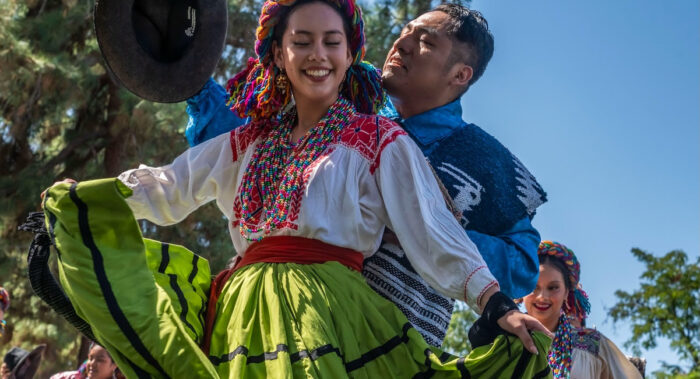
FRESNO, Calif. — According to Sarait Martinez, preserving culture is more than just continuing tradition, language, or custom. It is “a means of survival.”Martinez heads the Fresno-based non-profit Centro Binacional para el Desarollo Indigena Oaxaqueña, which advocates for Indigenous Mexican communities in and around California’s Central Valley. She helped organize Fresno’s September 28 Guelaguetza celebration, a fabulous display of dancers in elaborate masks and tall headdresses, performing to music from Indigenous towns in Mexico, particularly in the southern state of Oaxaca.
“As indigenous people from Oaxaca, we have celebrated the Guelaguetza now for 25 years,” said Martinez. “But this year it was especially important to do this, because of the threats of detention coming from ICE and the Trump administration. We could not let that stop us.”
This year’s festival in Fresno was called, “Resistance, Culture, Roots, Tradition.” The Centro Binacional and its sister sponsoring organization, Frente Indigena de Organizaciones Binacionales, called the Guelaguetza, “an offering or sharing, and in this celebration, we joyfully offer everyone our dances, the flavors of our food, regional music, and the traditions of Oaxacan culture.”
The main Guelaguetza is held in Oaxaca itself, but over the last four decades, the number of Mixtecos, Triquis, Chatinos, and other Indigenous peoples in the U.S. has grown so large that there are now several Guelaguetzas held each year north of the border. One 2016 study estimated that 350,000 indigenous Mexican migrants live in California.
This year, however, the Oaxacan community in Madera, about 20 miles north of Fresno, decided not to hold it for fear that people would be in danger of ICE raids. The Los Angeles Guelaguetza, often California’s largest, was cancelled after the city was caught in an intense series of raids and occupation by the National Guard.
Martinez said that the threat of raids didn’t deter the dozens of young people who came to volunteer this past Sunday to help organize the event. She estimated the crowd of attendees at several thousand.
The Fresno Guelaguetza was held at Fresno Community College and was broadcast live on Radio Bilingue, a chain of bilingual radio stations broadcasting to communities throughout the southwest. Some of its programming is in Indigenous languages and can be heard in Oaxaca itself.
Indigenous Oaxacan communities in the U.S. organize dance troupes that prepare all year for the event. The groups provide an opportunity to show off the vibrant culture, and to give young people growing up in the U.S. a chance to learn the language and dances, and to imagine a home they may have never seen. Many go on to perform in the dance troupes that travel through the state, dancing throughout the summer and fall.
The late Mixteco community leader Rufino Dominguez-Santos explained in a 2006 oral history that dance, and language are not just a way to celebrate identity, but are an essential glue that keeps communities together, helping them survive in a hostile environment.
“Beyond organizing and teaching our rights,” he explained, “we try to save our language. Even though 500 years have passed since the Spanish conquest, we still speak it. We are preserving our way of dancing, and rescuing our lost beliefs – that nature is something sacred for us, just as it was for our ancestors.”